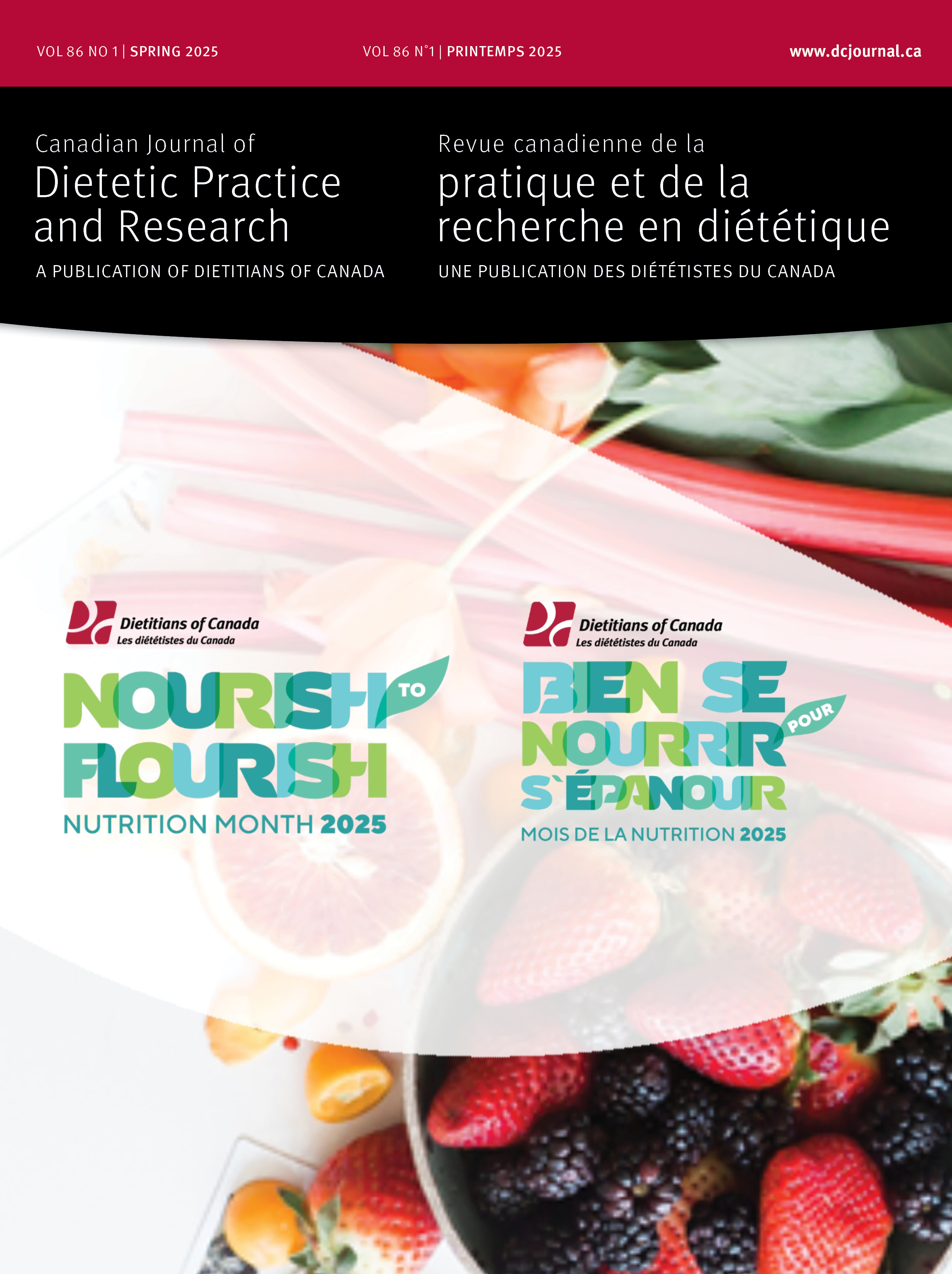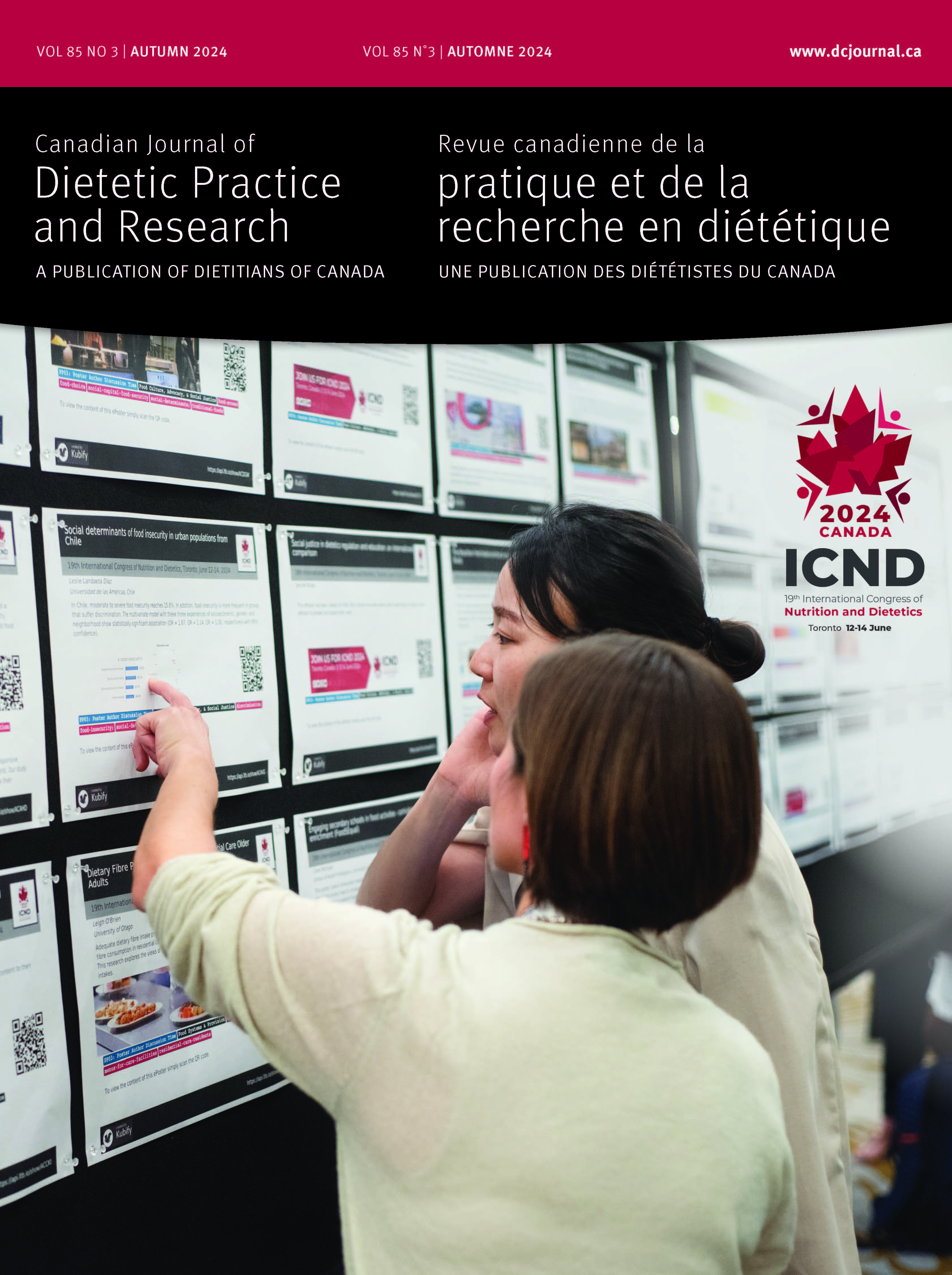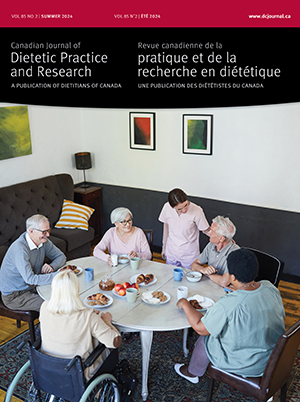Volume 84 • Number 3 • September 2023
Editor’s Message
Research
Purpose: To describe the breastfeeding experiences of a dietitian and mother so as to expose dominant discourses reinforcing expert-driven imperatives to breastfeed.Methods: Professional experiences and personal challenges related to breastfeeding promotion are described, analyzed, and interpreted using autoethnography. The social ecological model (SEM) is used as a sensitizing concept to guide the organization, presentation, and analysis of experiences.Results: Data were organized into two discussion themes: breastfeeding promotion practices and “failure” to breastfeed. Dominant discourses reinforcing expert-driven imperatives to breastfeed are revealed, including health as a duty, intensive motherhood, and mother blame. Discourses promoting or reinforcing breastfeeding simultaneously judge and denormalize formula-feeding.Conclusions: Contemporary breastfeeding promotion messages and strategies are quiet coercions used to influence infant-feeding decisions and do not support the principles of evidence-based practice, person-centred care, and informed choice.
Purpose: To assess knowledge of Canadian dietitians on the topics of food allergy and food allergy prevention guidelines, including introduction of allergenic solids to infants at risk of food allergy.Methods: An online survey was distributed via email listservs targeting Canadian dietitians.Results: In total, 144 of 261 dietitians completed the survey (60.5%). Respondents recommend introduction of peanut (89.5%) and allergenic solids (91.2%) within the recommended age of 4–6 months for infants at high risk of food allergy, but only 26.2% recommend offering peanut three times per week once it has been introduced. In identifying what constitutes an infant at high risk of developing peanut allergy, dietitians expressed lower comfort levels and lower number of correct responses.Conclusions: Dietitians demonstrated they are up to date regarding the timing of introduction of allergenic solids, but not the frequency of consumption once introduced, for infants at high risk of food allergy. They also expressed low comfort level identifying risk factors for peanut allergy. There are opportunities for further education of dietitians, as well as potential to further utilize dietitian services for the benefit of patients with food allergy or who are at risk for food allergy.
Objectif : Vérifier la stabilité temporelle et validité relative de la version française adaptée d’un questionnaire auto-déclaré en anglais mesurant la consommation de diverses boissons (BEVQ) chez les adolescents.Méthodes : L’adaptation française du BEVQ (AF-BEVQ) comprenait notamment la conversion des unités impériales en unités métriques et l’ajustement de certains formats selon ceux disponibles au Canada. Ensuite, 60 adolescents provenant de deux régions du Québec ont complété l’AF-BEVQ et deux rappels de 24 heures Web (R24W) (un jour de semaine et un de fin de semaine) à deux reprises à deux semaines d’intervalle.Résultats : L’AF-BEVQ avait des coefficients intra-classe (ICC) modérés pour les quantités de boissons sucrées (ICC : 0,68; intervalle de confiance [IC] 95 % : 0,46–0,81), de jus de fruits (ICC : 0,54; IC 95 % : 0,23–0,72) et d’eau (ICC : 0,66; IC 95 % : 0,38–0,81) consommées. Les quantités de boissons sucrées (rs = 0,49; p < 0,0001), de jus de fruits (rs = 0,38; p = 0,0024) et d’eau (rs = 0,65; p < 0,0001) rapportées dans l’AF-BEVQ étaient significativement corrélées à celles des deux R24W.Conclusions : L’AF-BEVQ présentait majoritairement des propriétés métrologiques adéquates. Il est un outil d’intérêt pour mesurer rapidement la consommation de boissons sucrées, de jus de fruits et d’eau d’adolescents francophones.
Perspectives in practice
Cystic fibrosis (CF) is a chronic condition requiring continued input from the CF dietitian as an integral part of the CF multidisciplinary team. In recent years, the longer life expectancy experienced by people with CF (PwCF) means that nutrition advice and therapy are evolving from a focus on nutrition support to prevention and management of comorbidities. Little has been reported regarding the perceived role of the CF dietitian amongst PwCF. We report the responses to 11 questions that were part of a larger international survey distributed to members of national CF charities in 2018-2019. These questions evaluated PwCFs’ perspectives on (i) the importance of the CF diet, (ii) how often PwCF obtain dietary/nutritional advice from their dietitian, (iii) the perceived reliability of information given by the dietitian, (iv) other sources of CF information and their perceived reliability, and (v) how CF nutrition/diet, as well as CF-related diabetes, ranked as research priorities. There were 295 respondents from 13 countries. Almost half of the respondents (46.8%) contacted their CF dietitian on a frequent/more regular basis, compared to medical/scientific journals/medical/scientific search engines. The CF dietitian was considered a reliable source of information, as 84% of the respondents indicated that the information provided was very/generally reliable. At a time when CF care and expectations are changing rapidly, PwCF are in need of trusted and reliable information to make positive changes in lifestyle and habits. Dietitians working with PwCF should appreciate the pivotal and valued role they perform as purveyors of robust evidence-based information to this chronic disease population.
It is important that breast cancer patients know where they can access evidence-based nutrition information because misinformation may lead to confusion for patients regarding dietary requirements, as well as potentially causing harm to health. There are gaps in knowledge about where and when patients seek nutrition information. Our exploratory study used telephone interviews to investigate where patients with breast cancer obtained nutrition information pre and postdiagnosis, and their preferred sources and timing for receiving nutrition information. We interviewed 29 women diagnosed with breast cancer who had attended the Cross Cancer Institute in Edmonton, Alberta. The structured interview included 13 closed-ended questions and 1 open-ended question. Interviews revealed that motives for seeking nutrition information changed between pre and postdiagnosis, but the sources did not. The majority of participants did not access a registered dietitian (RD) postdiagnosis but did specify that meeting with a RD would be their preferred source of information. Responses varied for the preferred sources and timing of nutrition information provision. Our study suggests that further research is necessary to know how to best meet the nutrition information needs of patients diagnosed with breast cancer.
Review
It is not known if nutrition risk screening of older adults should be a standard practice in primary care. The evidence in support of nutrition risk screening of older adults in primary care was examined and critically analyzed using an umbrella review. The peer reviewed and grey literature were searched for clinical practice guidelines (CPGs) and systematic reviews (SRs). Titles and abstracts were independently screened by the two authors. Resources were excluded if they did not apply to older adults, did not discuss nutrition/malnutrition risk screening, or were in settings other than primary care. Full texts were independently screened by both authors, resulting in the identification of six CPGs and three SRs that met the review criteria. Guidelines were appraised with the AGREE II tool and SRs with the AMSTAR 2 tool. The quality of the CPGs was high, while the quality of the SRs was low. The CPGs and SRs acknowledged a lack of high-quality research on the benefits of regular nutrition risk screening for older adults in primary care; however, CPGs recommended annual screening for older adults in primary care practices or other community settings. High-quality research investigating nutrition risk screening of older adults in primary care is needed.
Report
Purpose: This study compared anthropometric and body fat percent (BF%) equations in relation to measures of metabolic health.Methods: BF% calculations (Bergman, Fels, and Woolcott) and anthropometric measurements were used to determine obesity among a sample of patients attending primary care in Alberta, Canada. Anthropometric variables included body mass index (BMI), waist circumference, waist:hip ratio, waist:height ratio, and calculated BF%. Metabolic Z-score was computed as the average of the individual Z-scores of triglycerides, total cholesterol, and fasting glucose and the number of standard deviations from the sample mean.Results: Five hundred and fourteen individuals were included (41.2% male, age: 53 ± 16y, BMI: 27.4 ± 5.7 kg/m2). BMI ≥ 30 kg/m2 detected the smallest number of participants (n = 137) as having obesity, while Woolcott BF% equation categorized the largest number of participants as having obesity (n = 369). No anthropometric or BF% calculation predicted metabolic Z-score in males (all p ≥ 0.05). In females, age-adjusted waist:height ratio had the highest prediction power (R2 = 0.204, p < 0.001), followed by age-adjusted waist circumference (R2 = 0.200, p < 0.001) and age-adjusted BMI (R2 = 0.178, p < 0.001).Conclusions: This study did not find evidence that BF% equations more strongly predicted metabolic Z-scores than other anthropometric values. In fact, all anthropometric and BF% variables were weakly related to metabolic health parameters, with apparent sex differences.
Purpose: This study aimed to explore children’s lived experiences with the Ontario Student Nutrition Program (OSNP), a free, school-based snack program implemented in elementary schools in Southwestern, Ontario, Canada, to gain insights into future school food programs (SFP).Methods: Focus group discussions (n=17) were conducted with 105 children in Grades 5 to 8 in seven elementary schools. Focus groups were audio-recorded, transcribed, and coded for themes using inductive content analysis.Results: Overall, children appreciated the OSNP and felt that it filled a need in students. Children also reported a willingness to try novel food items. For future SFPs, participants recommended that input be sought from children to ensure food preferences were considered. Children also discussed wanting more appealing food offerings that may include some choice. Finally, children also mentioned wanting a fair and equitable distribution of food in classrooms.Conclusions: Children appreciated the OSNP and reported benefits to themselves and their peers. They also provided some valuable recommendations for future SFPs. If a nationally funded SFP is to be considered in Canada, children expressed the need to make the program equitable, while still allowing schools the flexibility to meet their unique needs and preferences.
Purpose: School lunches are of poor nutritional quality in Canada. Parents play an important role in the preparation of school lunches for young children. This study aimed to evaluate the acceptability and helpfulness of the Healthy Lunch Box Booklet (HLBB) to support parents in packing healthy school lunches for their children.Methods: The HLBB was distributed at four schools in London, Ontario to students in full-day Kindergarten to Grade three. Parents were asked to complete an online survey from April to November 2019.Results: Parents (n = 58) reported the HLBB to be helpful (96.3%) and found the sections on new school lunch and snack ideas and nutritional information (e.g., label reading) particularly useful. Some parents also stated that the HLBB created opportunities to interact with their children regarding school lunch preparation. In terms of perceived impacts, parents reported increased confidence (68.6%) and learning something new (79.6%) about school lunch preparation and felt that their children’s diet was impacted accordingly.Conclusions: The HLBB was found to be an acceptable and useful nutrition resource that supports parents in packing healthy school lunches for their children and therefore warrants further study.
Canadian Foundation for Dietetic Research
FREE ACCESS
The 2023 Dietitians of Canada (DC) National Conference held on 25–26 May 2023 was our first in-person conference since June 2019 and celebrated our unity and resiliency as a profession. It was amazing! The Canadian Foundation for Dietetic Research (CFDR) showcased a diverse array of experience sharing and research abstracts through oral and poster presentations, and virtual sessions. There were 23 Early Bird (EB) research abstracts, in which 10 were selected for in-person presentations during the conference, and 19 Late Breaking research abstracts which were posters. Thank you to all who submitted abstracts!Thanks to the dedication and commitment of the Abstract Review Committee members.Early Bird Abstract Review Committee: Susan Campisi (University of Toronto); Andrea Glenn (University of Toronto); Mahsa Jessri (University of British Columbia); Louise St-Denis (University of Montreal).Late Breaking Abstract Review Committee: Lesley Andrade (University of Waterloo); Carla D’Andreamatteo (Consultant, Winnipeg); Laura Forbes (University of Guelph); Billie Jane Hermosura (University of Ottawa); Christine Nash (University Health Network); Louise St-Denis (University of Montreal).Thanks to the CFDR Board, DC Conference team, digital partners, all of the moderators, and conference attendees for supporting the research presentations.Warm regards,Christina Lengyel, PhD, RDChair, 2023 EB/LB Abstract CommitteesProfessorFood and Human Nutritional SciencesUniversity of ManitobaRavi SidhuManaging DirectorDevelopment & OperationsCFDR










